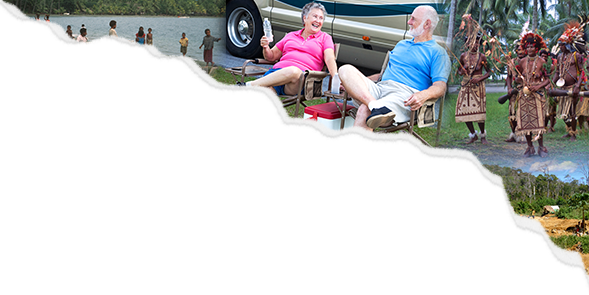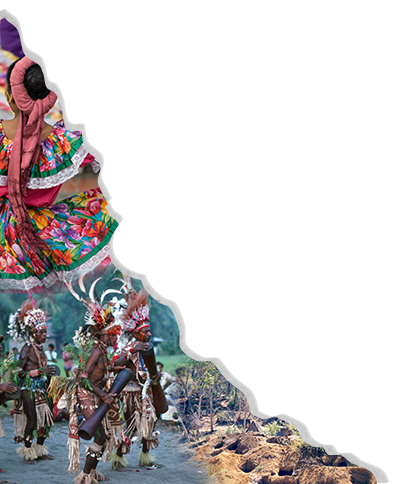Stanford University anthropologist and artist, Lochlann Jain, speaks with Anne Brackenbury (former editor at University of Toronto Press who launched the ethnoGRAPHIC Series) to talk about Jain’s new book, Things That Art: A Graphic Menagerie of Enchanting Curiosity.
This debut work of graphic non-fiction offers an opportunity to interrogate the concept of categories using text and image. Jain, a biracial, non-binary, interdisciplinary academic, is used to transgressing boundaries and this book offers a highly original way in which to understand the limits of categories while making visible the things that often get lost between. With over 50 works of original art, each based on fictional categories, and four interpretative essays, the book doesn’t just tell, it shows, in witty and sometimes profound ways, how we make sense of the world around us.
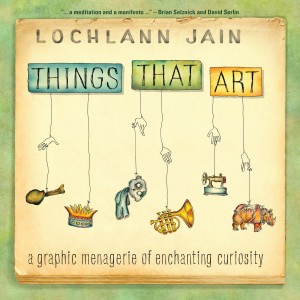 AB: Thanks for sitting down to talk with me. I have been excited about your artwork since you first showed it to me a number of years ago. And I’m thrilled that it will now be available in book form for more people to discover.
AB: Thanks for sitting down to talk with me. I have been excited about your artwork since you first showed it to me a number of years ago. And I’m thrilled that it will now be available in book form for more people to discover.
One of the book’s greatest strengths is that it is both a conceptual/philosophical exploration, but also seems to have real relevance for the world around us and the times we are currently living through. Who do you think will be drawn (sorry for the pun) to this book and how does it arm them for challenging (or dealing with) the world around them?
LJ: Speaking of goofy puns, the funny thing about this book is that it started as just a joke, really. I was in a faculty meeting doodling; the doodle became my colleague’s nose, and then a bunch of different kinds of noses emerged from my pen, which I put under a heading, “kinds of noses.” Right away with that first collection (my sister’s nose, the nose of wine, a porcine nose, etc.) an implicit set of questions arose: what noses know what, how do we distinguish and recognize noses, who gets to do the recognizing, and so on. It was nearly accidental that I drew the nose – and yet noses turn out to be so rich with meaning. Who knew noses were so political? At the time, drawing offered some solace during an unhappy period. I continued with that series among my other drawings, and over the years I drew over 100 of the Things That collection.
Things That Art both locates and creates frictions in the elements of the drawings: word, illustration, and collection. The goal is to undermine some of the expectations set up by the familiar forms that it builds on – that is, primarily the form of flashcard (word and illustration) and then the museum or zoo (curated collection of similar/related things). Many of the drawings use these elements to create little paradoxes and gaps where not everything matches up. The conceit of the project is that these gaps can shine a light on, and thus get an audience to think with me, about how categories work, and our assumptions about what belongs together and why/how. For example, how is money as a form of the representation of value (and state power) similar to lipstick as a form of representation and value (and gendered relations)? What kind of world/imagination makes these similar?
I found the form of the word/image/collection generative in that it could push a fundamentally poetic project (making connections and leaps among meaning, sound, and the shapes of letters and words) into a visual mode. Things That Art investigates the registers and grammars of naming and abstracting in relation to each other, sometimes in arbitrary ways. The conceptual leaps thus make intuitive before rational sense and can create possibilities for knowing otherwise, disturbing fixed identities, and lateral thinking. At least that’s the aspiration.
AB: I think this is what I found particularly exciting about this work. It doesn’t really ask: Which of these things don’t belong? Instead, it seems to ask: How are these things similar? That is a shift in the way we think, and therefore act, in the world. It suggests we are not individuals at the centre of life, but relational beings who make sense of the world in the way we relate to other beings/things. And as far as I can tell, that is hugely important for understanding how we might approach contemporary problems from climate change to artificial intelligence.
LJ: Wow yes, that’s a really great point. I hadn’t thought of it that way. And in truth, I can’t stand those children’s menu games of which doesn’t belong. This game is much more fun: how can we challenge and provoke new kinds of communities?
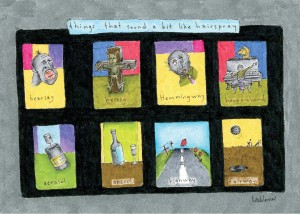 AB: So to take an example from the book – you created a collection of images under the label “Sounds like hairspray” which includes things like heresay, heresy, Hemingway, highway, fairway, harpsichord, aerosol, aperol. What prompted you to develop this particular category and how did you come up with these various “things” under this label?
AB: So to take an example from the book – you created a collection of images under the label “Sounds like hairspray” which includes things like heresay, heresy, Hemingway, highway, fairway, harpsichord, aerosol, aperol. What prompted you to develop this particular category and how did you come up with these various “things” under this label?
LJ: I found that sets of categories allowed me to look at things slightly askance, and so I informally cast about between drawings to see if I could access a range of those ways of looking. Sounds like hairspray just popped into my mind one day, as did the populating images and terms as something totally random and yet fully belonging to the collection. (For virtually all the cards I just used the first things that popped to mind, though for a few I asked friends and family for suggestions.) With that category, my curiousity was piqued to think about the reliance of category headings in determining our thinking. Consider for example the ways that gender-crossing has been described in different ways since the 1950s, in part influenced by contemporary and shifting notions of “headings” such as gender, biology, and binaries.
Thinking through the work of categories, I also played with vectors, such as negatives or playing with the notion, letters, and sound of “thing.” Another line of investigation considers information that is slightly creepy when listed together (things used to test car safety, or historical techniques of treating drowning victims). Another vector ends up presenting pseudo-information, such as, say, things with epi, which plays with linguistic groupings. And so on!
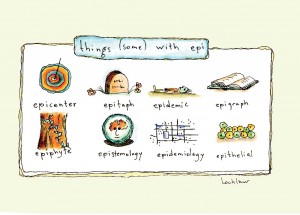 AB: The drawings in your book are very childlike. They exude a kind of innocence but also that uncensored honesty that children are known for. Was this intended or did it sort of emerge along the way as you started drawing?
AB: The drawings in your book are very childlike. They exude a kind of innocence but also that uncensored honesty that children are known for. Was this intended or did it sort of emerge along the way as you started drawing?
LJ: I have a couple of different ways of thinking about this question. First, there is a way in which abstracted knowledge forms are often presented as “elementary” – zoos and flashcards are for children and animals and illustrations are often presented in this naïve or cartoon style. Graphic charts will often simplify information as if the complexities were just noise. So I mimic this style on purpose. Perhaps an analogy to what I’m trying to do could be seen when “wild” things happen at the zoo that make frenzied parents cover their children’s eyes: the snake eats a live chicken whole, or the giraffe drinks the pee of the other giraffe.
Second, I drew this over the course of 8-10 years, and so the style of images progressed with it. I redrew most of the early images that I include in the book, but the curious reader will still be able to divine the timeline of the drawings both conceptually and graphically, and I purposely made that part of the project. The idea is definitely, as you say, to present a straight-forward illustrative framing – even misleadingly simplistic. I think that works for what I am aiming toward with the project in terms of using simplified drawings and words to push the conceptual elements of word and image in various representational economies (art, economics, gender, marketing, grammar, charting, etc.). I’m hoping that in this way the reader will be surprised when they experience the darker and more conceptual elements of the project. Still, if I had continued the series I would have been interested in pushing in different ways on the illustrative dimension to see how to challenge that form. This was perhaps a good indication that this project had reached a natural conclusion.
AB: The use of some more grotesque images and cuss words seems deliberate. Were you wanting to shock the reader or make them laugh or get at something more authentic?
LJ: I have always been interested in how at base, so many insults are simply meaningless – as a person of half-Indian descent, even though my father disavowed everything Indian except the sweets (which I still love), my sisters and I were occasionally called “Paki.” This could be painful even though (a) not strictly true, and (b) not in fact an insult. When we were kids my best friend used to whisper that “bastard” was the absolute worst thing someone could say. Another virtually meaningless word. And once when a kid named Craig was teasing me about my name, my mother suggested I call him “craggy mountain,” which I did. It infuriated him. These swears and insults indicate how language is both meaningless at one level, and extraordinarily active and effective on another. The collection “Things generally used as insults” aims to open this gap between the innocence of the thing that suddenly finds itself exploited as an insult, the word with its different textures and meanings, and the thing we already know or imagine, which is the person to whom the insult is addressed. The purpose then is not really to shock or to make someone laugh, but to crowbar the gap between word, thing, and meaning in a context where there is already only a tenuous relationship. These words are so often used as linguistic pellets of exclusion, so I wanted to literally draw the odd-balls back into the equation.
I was kind of amazed and intrigued to see how this form I’d developed for the initial nose drawing became so useful as an interpretive and experimental device: I sort of loved seeing what would happen as I kept slotting different ideas through the keyhole.
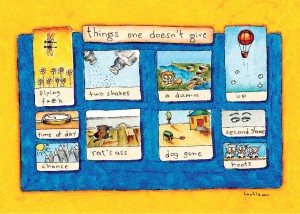 AB: If you were taking a transatlantic flight, what would you bring with you to read/look at/watch? (Or would you just watch an inflight movie?)
AB: If you were taking a transatlantic flight, what would you bring with you to read/look at/watch? (Or would you just watch an inflight movie?)
LJ: My flights are so boring! Once I get over the initial disappointment of no free upgrade, I use the time to catch up on email, write reviews and reference letters, and catch up on other work. I do like watching in-flight movies though because they tend to be better at altitude. I’ve always thought that and someone recently told me that it’s a real thing.
AB: Really? What is it about altitude that makes a movie better??
LJ: Something about being packed in the space with others, the stress, and so on. Maybe the movies aren’t as good in business class because there is more space and fewer people; we’d need to gather some data on that.
AB: Will you ever write a purely textual book again? Or are you hooked on the image/text relationship for good?
LJ: I’m currently working on several projects, and I think the projects tell me what genre they are meant to be, in a way. The history of hepatitis B I’m working on would make a great graphic novel. But there are many fascinating details and a complex argument that lends itself to text. I’m also working on a graphic novel (for lack of better word) called My Failed Transition, about the weird and wonderful aspects of a gender non-binary existence. Finally, I’ve been working on a series of drawings related to the history of technology and discovery of air.
AB: Some people think you can make complex theoretical arguments in the context of a graphic novel but I get that text is sometimes the most appropriate format to work out a theory or argument. Once it is worked out though, a graphic novel of hepatitis B would be wonderful! Don’t rule it out. And a graphic novel on your transition would be more than welcome as well. I assume the graphic novel is a natural fit because of the growing interest in graphic memoir and its ability to capture memory and experience more viscerally?
LJ: Note the book is on my Failed Transition, that’s a crucial point but I’m not sure why yet. It’s still in process as an idea, but the goal will be to experiment with text and images in new ways and work out the ideas that way. I don’t think graphic memoir is any more visceral than words per se, it’s more about the fit among ideas and author. I will always be a huge proponent and admirer of words and text. In my view it’s tragic that in general people don’t read as much. Many of the social and even academic conversations I used to have about books are now about Netflix.
AB: So do you think scholarly communication is changing with the growth of the digital humanities, comics, podcasts, games, and other multimodal formats?
LJ: It’s an exciting time to be an academic in the sense that there are spaces and opportunities to do more innovative and experimental work. When I first started in the academy about 25 years ago, the questions (and answers) were more staid and uninteresting; this wasn’t because they had to be textual, but because of the self-generated ideas for evaluation which were based less on originality and rigor than on disciplinary canons. Stanford asked me to resign three or four years after I was hired because my colleagues didn’t consider my first book to be anthropological enough, though they had hired me, technically, as an STS scholar and supposedly read the dissertation on which the book was based. Since I was in the middle of cancer treatment and had two small children, I realized in a very deep way how excruciatingly vulnerable scholars are to the judgements and tastes of senior academics and so how beholden we are to try to second-guess what they might want. For those institutional reasons it has been tremendously difficult to open the academy up to new questions and forms of investigation. But I see a change with the current generation of now senior professors more open to seeing and appreciating new kinds of work. Or maybe that’s just the small academic world in which I travel.
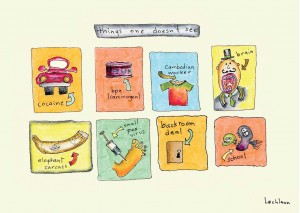 AB: I think it’s more than just the world in which you travel. I believe the academy is making changes (albeit small changes) as the world around it changes. Things That Art is a book about categories that is not easy to categorize. If you were a bookseller and had to file this away in a particular section, which would you choose?
AB: I think it’s more than just the world in which you travel. I believe the academy is making changes (albeit small changes) as the world around it changes. Things That Art is a book about categories that is not easy to categorize. If you were a bookseller and had to file this away in a particular section, which would you choose?
LJ: I’d probably file it with art books or graphic novels. I think it would appeal to folks who like to look at, and think with, pictures and I’m super excited to see where the popularity of this genre will go – I think there is so much untapped potential to work with word-concept-image that is just now being explored, and I envision that we will come up with a series of new terms that expand the graphic novel category: graphic biography, philosophy, memoir, etc.
AB: Yes there are many different genres emerging with forms like graphic medicine, graphic journalism, and of course, graphic memoir, but I like the way Things That Art charts its own space in that growing field as a graphic philosophy of sorts that uses the medium in a highly original way to show and tell how we sort information, thoughts, and concepts.
So who do you see as the audience for this book? Scholars? Artists? Students? The general public?
LJ: Which categories of people will like the book? I sense a new card to be drawn!!
But seriously, one of the things I appreciate about the project now that it has been put together as a collection, is that I keep finding new ways into it, and it keeps surprising me. I’ve been thinking for example about how the range of representation works across the collection: charts, maps, graphics, dollar bills, diagrams, etc. … how do things that are already representations of things operate as things? I discuss some of that in my essay, but there is more there to mine. So I guess the point is that I can still entertain myself with my little paper mates, and the ability to self-entertain is a crucial part of living a happy life.
AB: Thanks for speaking with me. I’m excited to see how people respond to Things That Art. And I’m excited to see where your interest in art/visual formats and your scholarly research go in the future.
LJ: It has been great!! Thank you for all you have done to spearhead new work thinking across genres.
Lochlann Jain is a professor in the Department of Anthropology at Stanford University and a professor in the Department of Global Health and Social Medicine at King’s College London.
Want to learn more from Things That Art?
